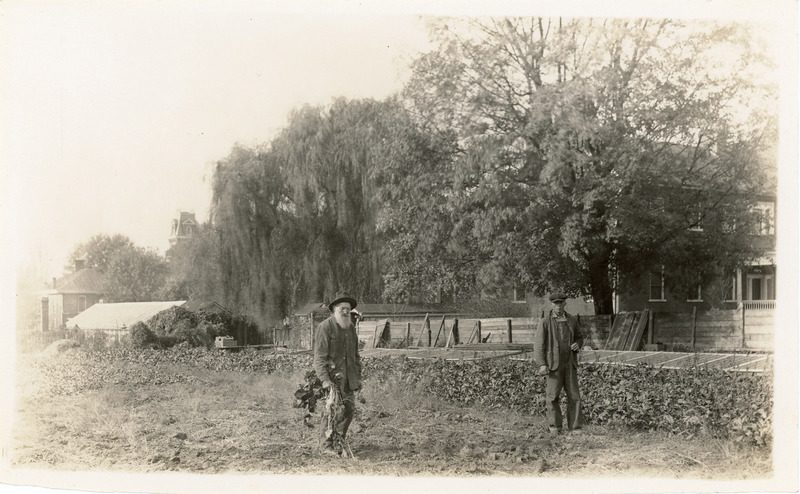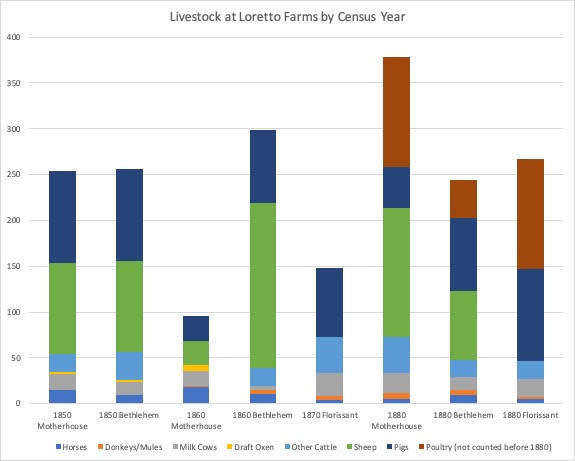Glimpses of Loretto’s Agricultural Past
Posted on May 31, 2023, by Susanna Pyatt
While the Loretto Heritage Center contains a lot of archival papers that document Loretto’s past, one aspect that is difficult to see in the archives is the history of agriculture at the Motherhouse and other convents. Perhaps this is because Loretto’s focus was on education, with agricultural work delegated to enslaved people, hired men, and only a small number of Sisters. Even though the raising of livestock and crops was an important source of food and even income for Loretto, this essential work received scant attention in official records.
As with Loretto’s history of enslavement, census records can provide glimpses of history that did not make it into the archives. In the case of farming, there were federal agricultural censuses taken every ten years between 1840 and 1920. We have been able to identify the Loretto Motherhouse (Nerinx, KY), Bethlehem Academy (St. John, Hardin County, KY), and Loretto Academy (Florissant, MO) in several of these agricultural censuses from 1850 to 1880.

Image from the Loretto Heritage Center collections
The census records provide some insight into the types of agriculture and subsistence at these Loretto locations, as well as how agriculture varied over time. For instance, the amount of land possessed by the Sisters of Loretto increased over time, with a maximum of 2,666 acres between the Motherhouse, Bethlehem, and Florissant in 1880. Much of the agriculture likely focused on raising livestock for meat, butter, wool, and eggs. Typical livestock included milk cows, beef cattle, sheep, pigs, and poultry. Horses and donkeys or mules appear to have been used as draft animals more than oxen. According to the censuses, the Sisters did not make cheese or sell milk, but they produced a prodigious amount of butter—one of their farms could produce as much as 3,700 pounds per year!

Wheat was grown at all three locations, though Florissant grew at least twice the amount as the other two farms. Corn was also a significant crop. Oats and, sometimes, rye came in at a distant third place for grain yields. Relatively small amounts of beans or cowpeas were sometimes grown. Both white potatoes and sweet potatoes were cultivated, though white potatoes were grown in greater abundance. While the Sisters did not grow cotton, and they phased out flax, the farms often produced a couple hundred pounds of wool in the surveyed years. Florissant grew two dozen tons of hay in 1870 and 1880, while the other farms grew little or none. By 1880, all three farms reported apple orchards, and the Motherhouse also had a 2-acre peach orchard, but not all of these were listed as productive during the census years. With the exception of the Motherhouse in 1880, none of the farms included vineyards or wine production.
Production of Selected Farm Goods, 1850-1880
| Location | Wheat (bushel) | Rye (bushel) | Corn (bushel) | Oats (bushel) | Peas/Beans (bushel) | White Potatoes (bushel) | Sweet Potatoes (bushel) | Hay (ton) | Butter (lbs) | Wool (lbs) | Flax (lbs) |
| Motherhouse (1850) | 120 | 0 | 1500 | 100 | 10 | 40 | 30 | <1 | 500 | 100 | 200 |
| Bethlehem (1850) | 200 | 100 | 1000 | 300 | 10 | 40 | 10 | 0 | 800 | 300 | 0 |
| Motherhouse (1860) | 600 | 100 | 3000 | 600 | 10 | 200 | 35 | 5 | 500 | 250 | 40 |
| Bethlehem (1860) | 560 | 0 | 4500 | 0 | 0 | 0 | 30 | 1 | 10 | 0 | 0 |
| Florissant (1870) | 1680 | 0 | 6400 | 220 | 0 | 450 | 0 | 24 | 3750 | 0 | 0 |
| Motherhouse (1880) | 450 | 0 | 1600 | 300 | 7 | 600 | 350 | 0 | 2500 | 450 | 0 |
| Motherhouse (1880) | 1100 | 0 | 4000 | 125 | 0 | 125 | 50 | 0 | 600 | 318 | 0 |
| Florissant (1880) | 0 | 0 | 2500 | 0 | 0 | 150 | 0 | 25 | 2000 | 0 | 0 |
The assumption is that most or all of the food and other agriculture goods produced on Loretto farms was used by the convents and schools. Each of the three locations was home to several dozen Sisters, students, and enslaved or hired laborers, and goods from the farms were likely transported to other Loretto foundations. Most of the crops were not typical cash crops of the time, though tobacco does appear in the 1860 census for Bethlehem. Further research that compares the agricultural census records with surviving account books from each of the three sites is needed in order to determine how much agriculture contributed to Loretto’s income in the 19th century.
